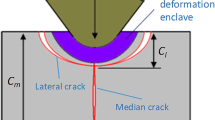Abstract
Hybrid technologies offer an important approach to enhance existing limits of conventional cutting manufacturing processes. Superposition of the infeed with adapted ultrasonic vibrations enables reductions of machining forces. This results in diminished tool wear and longer tool life. Furthermore, an increase of removal rates can be achieved. Successful machining of recalcitrant metal-based materials by ultrasonic assisted systems creates a high potential to gain similar effects in machining of mineral-based materials. This will be studied in this article. The state of the art for the machining of stone uses geometrically undefined cutting edges. This paper focuses on the geometrically defined cutting of granite with additional ultrasonic assistance. Cutting tests at a test station with linear cutting motion are being performed. The ultrasonic frequency is maintained at 20 kHz. Different oscillation amplitudes are applied to influence process forces and the wear of the used carbide metal and polycrystalline diamond cutting segments (PCD). A method to observe the wear is developed by use of a stereomicroscope and a 3D measurement system. This will enable conclusions about the applicability of the geometry of the cutting segments and the process parameters. Due to the significant different wear rates of both cutting materials, the cutting force progression by using PCD tools shows completely different characteristics compared to the machining with carbide metal tools.







Similar content being viewed by others
References
Neugebauer R, Stoll A, Roscher H-J (2009) Ultraschallunterstützung verbessert Tiefbohren in hochfestem Guss. MM—Maschinenmarkt. Das IndustrieMagazin. http://www.maschinenmarkt.vogel.de/themenkanaele/produktion/zerspanungstechnik/articles/198111. Accessed 20 June 2013
Zäh M (2012) Die Werkzeugmaschine der Zukunft. Leichter schwer zerspanen. 1st edn. Herbert Utz Verlag, Garching, pp 3
Risse A (2012) Fertigungsverfahren der Mechatronik, Feinwerk- und Präzisionsgerätetechnik, 1st edn. Vieweg + Teubner Verlag, Wiesbaden, pp 198–201
Treppe F, Hochmuth C, Schneider R, Junker T, Schneider J, Stoll A (2011) Steigerung der Ressourceneffizienz durch hybride Prozesse. Nachhaltige Produktion, Hannover, pp 127–150
Oppermann B (2002) Keramik bleibt hart, aber die harten Zeiten für die Werkzeuge sind vorbei. Industrieanzeiger. http://www.industrieanzeiger.de/automation/-/article/12503/28887548/Keramik-bleibt-hart,-aber-die-harten-Zeiten-f%C3%BCr-die-Werkzeuge-sind%0Avorbei/art_co_INSTANCE_0000/maximized/. Accessed 10 July 2013
Klocke F, Weber A, Bresseler B (2006) Ultraschall steigert Effizienz beim Schleifen sprödharter Werkstoffe. MM—Maschinenmarkt. Das IndustrieMagazin. http://www.maschinenmarkt.vogel.de/themenkanaeleproduktion/spanendefertigung/maschinen/articles/48905. Accessed 11 July 2013
Klocke F, Bresseler B, Weber A (2004) Ultraschallunterstütztes Schleifen—Chancen und Grenzen der Technologie am Beispiel der Zerspanung von Glas und Glaskeramik. wt Werkstattstechnik, online, pp 258–262
Cardoni A, Harkness P, Lucas M (2010) Ultrasonic rock sampling using longitudinal—torsional vibrations. Ultrasonics 50(4–5):447–452
Heisel U, Eisseler R, Eber R, Wallaschek J, Twiefel J, Huang M (2011) Ultrasonic-assisted machining of stone. Prod Eng 587–594. doi:10.1007/s11740-011-0330-1
Brehl DE, Dow TA (2008) Review of vibration-assisted machining. Precis Eng 32:153–172
Eber R (2010) Ultraschallunterstützte Bearbeitung von Gestein hat Potential. IFW News
Heisel U, Eber R, Wolf G, Wallaschek J, Twiefel J, Huang M (2011) Investigations on ultrasonic-assisted drilling and milling of stone. In: 1st International conference on stone and concrete machining, pp 117–122
Gerlach, D (2010) nm 15: Kleine Bewegung ganz groß!. Naturstein. pp 64–65
Reichenbächer, H (2010) Trennen mineralischer Werkstoffe mit geometrisch bestimmten Schneiden. Dissertation. University of Kassel
Böhm S, Scherm W, Schwarte S, Heise C (2012) Bearbeitung von Stahlbeton mit geometrisch bestimmter Schneide aus PCD. Diamant Hochleistungswerkzeuge (dihw), pp 28–35
Böhm S, Schwarte S (2012) Machbarkeitsstudie zur Bearbeitung von Stahlbeton mit geometrisch bestimmter Schneide aus PCD. Progressive industrielle Technologien, Minsk, Belarussische Nationale Technische Universität, Internationale wissenschaftlich-technische Konferenz
Böhm S, Schwarte S, Heise C (2013) PKD trennt Ultrahochfesten Beton unaufhaltsam. Diamant-Hochleistungswerkzeuge (dihw), pp 6–12
Achenbach M (2013) Schlag auf Schlag—system-simulation für das Schlagwerk eines elektro-pneumatischen Bohrhammers. Ölhydraulik und Pneumatik, pp 38–41
Pauksch E, Holsten S, Linss M, Tikal F (2008) Zerspantechnik - Prozesse, Werkzeuge. Technologien, Vieweg und Teubner, Kassel
Author information
Authors and Affiliations
Corresponding author
Rights and permissions
About this article
Cite this article
Heise, C., Böhm, S., Schwarte, S. et al. Hybrid cutting of granite by use of ultrasonic assistance. Prod. Eng. Res. Devel. 8, 567–575 (2014). https://doi.org/10.1007/s11740-014-0548-9
Received:
Accepted:
Published:
Issue Date:
DOI: https://doi.org/10.1007/s11740-014-0548-9




